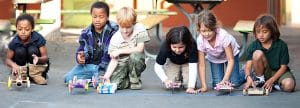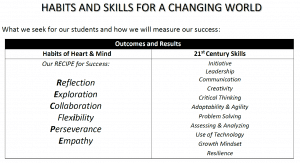A Hybrid On-Campus and Homeschool Support Program at Da Vinci Connect
CompetencyWorks Blog

The Da Vinci Schools are a network of five charter schools in Los Angeles. Their charter authorizer is the Wiseburn School District, with whom they share central office space. Dr. Matt Wunder, Da Vinci’s long-time CEO, described Wiseburn as “the wind beneath our wings.” The first Da Vinci school opened in 2009.
Three of Da Vinci’s schools, which each occupy a floor of a new school building connected to the Wiseburn district office and Da Vinci Charter Management Organization, serve as the district’s primary high schools. Each has a distinct career focus and name: DV Communication, DV Design, and DV Science. More than 900 students are on the wait list to enter 9th grade at these project-based learning high schools.
The other two schools—DV ConnectX and DV RISE High—are independent study programs that provide a pathway for student schedules and activities to be flexible and innovative. DV Connect and Da Vinci Extension have recently merged to become Da Vinci ConnectX, one of the first programs in the nation that serves students in transitional kindergarten through college. [Update: Da Vinci subsequently renamed the merged school to DV Connect rather than DV ConnectX.] Once students reach 9th grade, they can begin an innovative dual enrollment program and earn an associate’s degree or even a bachelor’s degree while completing their high school requirements. DV RISE High is a high school for students experiencing housing instability, in the foster care system, extremely credit deficient, or a combination of these and similarly acute challenges.
Da Vinci provides an exceptionally entrepreneurial, problem-solving approach to meeting the needs of students. Obstacles and community needs are consistently met with creative solutions that expand the boundaries of the existing system. At the same time, Wunder is clear about his indebtedness to other innovative models, saying “As effective curators, we’ve tried to pick the best practices from other models. But our philosophy is we’re not trying to create one school as the best prototype school. We took seriously that charters were supposed to be the research and development arm of public education.
“So we have five mostly different schools from each other. I think people more and more want choice. That’s not a political statement. People want to be able to customize education for their child. They all come here for different reasons. ‘My kid’s getting bullied.’ ‘My kid is medically fragile.’ ‘My kid’ is highly gifted.’ ‘I want my kid to learn by doing and not take so many standardized tests.’ ‘My kid is entrepreneurial and wants to pursue it.’ There’s a myriad of reasons, and it really allows the most flexibility and the most innovation.”
This is the first of two blog posts on the Da Vinci Schools. My visit was before the COVID-19 pandemic, so the series mostly reflects Da Vinci’s approaches before the school closures. However, two Da Vinci staff members kindly provided updates on their current operations during the pandemic.
Da Vinci ConnectX
DV ConnectX’s Assistant Principal, Kaitlin Toon, explained that the school is grounded in three signature practices: project-based learning, homeschooling, and strong social-emotional learning practices. “Those are the three things that most families gravitate towards us for, whether it’s one or all.” The school attracts both veteran homeschoolers and families who haven’t home schooled before but like what DV ConnectX offers.
The school provides students the opportunity to spend two six-hour days on campus focused on project-based learning across subject areas, with an emphasis on social-emotional learning and 21st-century skills in a collaborative, project-based classroom setting. Some student projects have included kindergartners creating and demonstrating Rube Goldberg machines, 4th– and 5th-graders building models of sustainable “tiny homes” as a possible solution for the homelessness crisis in Los Angeles, and middle-schoolers performing rock operas based on the scientific revolution.

Parents and guardians, which DV ConnectX calls “parent educators,” receive group and individual supports from DV ConnectX teachers to supervise their children’s academic and social-emotional work, incorporating project-based and experiential learning. In addition to curriculum resources and support offered to every family, parent educators can participate in virtual and in-person workshops to help them be better teachers for their children. The week I visited, the school was holding a conference with 25 workshops for parent educators on reading, writing, and math instruction, social media use, and self-care. DV ConnectX offers about 300 of these workshops per year.
“Public homeschooling” approaches such as DV ConnectX are yet another potential route to achieve personalized, competency-based education. They enable elements such as flexible pacing and pathways, timely and differentiated supports, student agency, and meaningful assessment. (The California Department of Education explains, “Independent study serves students who desire to accelerate or move more slowly through a course, or to make up a subject that they have missed in a traditional classroom.”) Another element of competency-based education is rigorous common expectations that are explicit and transparent, and DV Connect provides an extensive resource of these expectations on their website’s Learning Targets page.
The common expectations in competency-based education apply not only to academic knowledge, but also to skills and dispositions. DV ConnectX calls these “Habits of Heart and Mind” and “21st Century Skills,” as shown in the figures below (and available as originals in the Student and Family Handbook). They seek to achieve these habits and skills through their learning activities at home, on field trips, and on campus.


DV ConnectX’s charter specifies extensive teacher supports for homeschooling parents, rather than a hands-off approach when students are off campus. Detailed responsibilities for students and parents are also specified in the student and family handbook. Approved independent programs in California document the supports they provide as well as student outputs in order to receive full-time per-pupil funding allotments. On-campus days are accounted for by taking attendance, and students and parents need to submit a daily log or work journal for off-campus days.
“In some independent study programs, this documentation is a quick ‘We did work today,’ and that’s it,” Wunder said. “We don’t think that’s what best for kids, so we have an outline of the Common Core standards that we’d like the families to work on. We also provide curriculum to help them work on those, although they’re allowed to do anything they’d like, so long as its secular. The curriculum we offer is wonderful and tailored for parents, which a lot of independent study schools don’t do. They’ll push out curriculum to families that’s meant for educators, and the families don’t know how to use it.”
“Our program expanded and exploded in a way that we had not expected,” Wunder said. “Home-schooling families wanted a hybrid system that would provide community and support at school, but parents and guardians also wanted to be with their children more, and to be more in charge of what and when their children learn.”
Notably, homeschooling with public support is not limited to charter schools. During my recent visit to the public Chugach district, I learned that they support clusters of homeschooling families in Anchorage, in smaller towns, and in remote areas of Alaska. Many other Alaskan schools districts also support homeschooling.
During the time of COVID-19 school closures and beyond, it’s important to learn from models such as DV ConnectX that support caretakers as educators. “Our decade of experience with supporting homeschooling families enabled us to shift to virtual learning within three days of California’s ‘Safer at Home’ order,” Toon explained. “We are providing flexible but consistent distance-learning content to families through a variety of learning resources including curriculum, teacher-generated lesson plans and resources, live and pre-recorded virtual lessons, and virtual opportunities to connect and build community.” These social opportunities have included scavenger hunts on Zoom, a virtual Star Wars party, and a virtual talent showcase. Given the isolation, stress, and trauma brought on by the pandemic and school closures, the school’s focus on social-emotional development and building a connected community is an essential element of meeting students’ needs.
The next blog post on the Da Vinci Schools explores the older grades of Da Vinci ConnectX, in which students focus on real-world learning and dual enrollment in pursuit of college degrees while completing their high school requirements.
Learn More
- Earning Diplomas and Degrees Together – A Competency-Based Dual Enrollment School
- Performance-Based Home Schooling
- Habits of Mind and Learning New Ways of Learning at Journey Elementary
Eliot Levine is the Aurora Institute’s Research Director and leads CompetencyWorks.